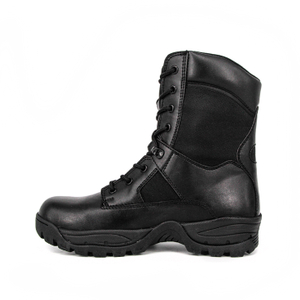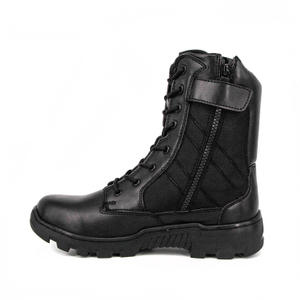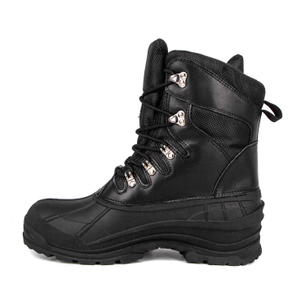Combat boots are an essential piece of gear for anyone in the military, law enforcement, or outdoor adventuring community. Their rugged design, durability, and typically waterproof features make them suitable for tough terrains and high-stress environments. Whether you're in the army, a hiker seeking long-lasting footwear, or someone simply appreciating tactical fashion, getting used to combat boots can be a challenge.
Breaking in combat boots is a rite of passage. While they're built for endurance, protection, and performance, new boots can be stiff and unforgiving at first. But with the right approach, you can significantly reduce the pain and time it takes to make your boots feel like a second skin.
In this comprehensive guide, we'll dive into how to break in combat boots, how long it typically takes, and what to do (and not do) to avoid pain and blisters. We'll also cover the best tools, tricks, and modern trends in military and army footwear technology to help you make smart choices along the way.
Are Boots Supposed to Hurt at First?
Yes, it's quite common for new combat boots to cause discomfort initially. These boots are built with resilience in mind, using tough leather or synthetic materials designed to endure harsh environments. That means they're often stiff, especially around the toe box, heel, and ankle support areas.
Unlike running shoes, which are ready to wear straight from the box, combat boots require a break-in period to mold to your feet. This is especially true for military-issued boots, which prioritize durability over instant comfort.
How Do I Stop My Boots from Hurting My Feet?
To reduce pain and prevent injury during the break-in process:
Invest in quality socks: Thick, cushioned socks absorb friction and reduce pressure points.
Use moleskin or blister pads: Apply to sensitive areas before discomfort starts.
Apply petroleum jelly or anti-chafing balm: This minimizes friction during long walks.
Loosen laces slightly: Avoid tying your boots too tightly at first.
Use orthotic insoles: These improve arch support and cushioning.
How Long Does It Take to Break in Boots?
On average, it takes 1 to 3 weeks to fully break in a pair of combat boots, depending on the material, design, and how often you wear them.
| Boot Material | Break-In Time | Comfort Level After Break-In |
| Full-grain leather | 2–3 weeks | High |
| Synthetic leather | 1–2 weeks | Moderate |
| Suede/Nylon mix | 1 week | Moderate to High |
What Is the Fastest Way to Break in New Combat Boots?
While patience is key, there are accelerated methods to help soften the material and reduce the break-in time. Here are the two most effective:
The Wet Method
This method softens the leather faster but should be used with caution.
Steps:
Fill your boots loosely with warm water (not hot).
Let them sit for 15–20 minutes.
Pour out the excess water and put on thick socks.
Wear the damp boots until they dry (this could take several hours).
Pros: Fast results, molds to your foot shape quickly.
Cons: Can damage non-waterproof boots or the glue in synthetic materials.
The Dry Method
A safer and more controlled method.
Steps:
Use a leather conditioner to soften the upper material.
Insert boot stretchers or stuff with newspaper overnight.
Wear for short intervals over several days.
Pros: Maintains boot integrity.
Cons: Takes more time.
How to Break in New Boots the Right Way: The Dos
Taking a systematic and gentle approach ensures your combat boots last longer and feel better.
Use a Leather Conditioner
Conditioners help soften tough leather and prevent cracking. Apply a generous layer to the boot's surface and let it absorb overnight. For military-grade combat boots, choose conditioners compatible with waterproof materials to maintain resistance to wet conditions.
Try a Boot Stretching Spray and Boot Stretchers
Boot stretching sprays temporarily relax leather fibers. Combine with a boot stretcher to expand tight areas, especially around the toe box or heel.
Pro Tip: Use boot stretchers overnight for best results, especially for army boots that use thicker leather.
Wear Thicker Socks and Additional Padding
Thick, moisture-wicking socks reduce pressure points and friction. You can also add heel grips or gel pads to cushion high-stress areas like the ankles and arches.
Bonus: Military-issue socks are designed for long marches and are a great choice for added comfort.
Boot Bends and Damp Cloth
Manually flexing the soles of your combat boots mimics walking and helps loosen the material. Wrap the boots in a damp cloth and bend the soles back and forth for several minutes.
Try Out Different Lacing Combos
Lacing can make or break your comfort. Experiment with:
Army ladder lacing: Offers firm ankle support.
Window lacing: Relieves pressure on the instep.
Surgeon's knot: Prevents heel slip.
Start Gradually and Be Patient
Wear your boots around the house or on short walks before committing to a full-day hike or military drill. Gradually increase wear time by 1–2 hours daily.
The Don'ts of Breaking in Boots
Avoiding common mistakes can save your feet from unnecessary pain and your combat boots from damage.
Don't Ignore Discomfort, Thinking It'll Get Better on Its Own
Persistent pain is a sign of a poor fit. Continuing to wear ill-fitting boots can cause long-term foot issues like plantar fasciitis or nerve compression.
Don't Expose Your Boots to Direct Heat Sources
Never use a hairdryer or fireplace to dry or soften your boots. Excessive heat can warp the soles, damage adhesives, and reduce waterproof integrity.
Don't Submerge Your Boots in Water
Soaking boots might seem like a fast fix, but it can ruin the internal structure, especially in non-waterproof models.
Don't Overstretch Your Boots
Using excessive force with boot stretchers or manually stretching leather can tear seams or permanently deform the boot's shape.
Don't Rush the Breaking-In Process
Trying to wear new combat boots for a full 12-hour military shift is a recipe for blisters. Take your time and let the boots adapt to you.
And, Whatever You Do, Don't Skip on Boot Care
Proper maintenance extends the life of your combat boots and ensures they stay comfortable long after the break-in period.
Care checklist:
Clean boots after each use, especially after exposure to mud or salt.
Apply waterproofing spray regularly, even for waterproof boots.
Store in a cool, dry place to prevent mold and odor buildup.
Re-apply leather conditioner monthly to keep the material supple.
Replace insoles every 6–12 months for optimum support.
Proper boot care doesn't end with the break-in period. Discover how to keep your leather combat boots in top condition with our expert tips in 'How to care for combat boots?'
Conclusion
Breaking in combat boots may seem daunting at first, but with the right techniques and tools, you can make the process smoother and more comfortable. Whether you're preparing for a military deployment, a tactical training course, or a rugged hiking trip, understanding how to properly break in your boots is essential for performance and foot health.
From using leather conditioners and boot stretchers to experimenting with lacing and gradually increasing wear time, there are many ways to ease the transition. Avoid common pitfalls like using heat or ignoring discomfort, and always prioritize care and maintenance to get the most out of your investment.
Whether you're wearing army-issued combat boots or a high-end waterproof model for personal use, patience and preparation are key. The boots may be tough, but with the right approach, so are you.
FAQs
Q: How do I know if my combat boots fit properly?
A: Your toes should not touch the front, your heels should not slip, and there should be no pinching. Always try boots with the socks you plan to wear.
Q: Can I wear new combat boots in the rain?
A: Only if they're waterproof. Otherwise, moisture can damage the materials and cause discomfort.
Q: Are military boots different from civilian combat boots?
A: Yes. Military boots are designed to meet strict standards for performance, durability, and uniform regulations, while civilian models may prioritize style or comfort.
Q: Should I buy combat boots a size larger?
A: Not necessarily. If you're planning to wear thick socks or orthotics, a half-size up may help. Otherwise, stick to your measured size.
Q: How do I maintain the waterproof quality of my boots?
A: Reapply waterproofing sprays or waxes monthly, especially after cleaning or heavy use.























